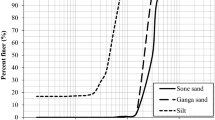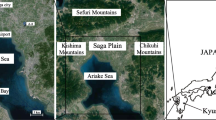Abstract
The existence of thick compressible varved clayey silt deposits along the Delaware River presents one major obstacle for design and construction of structures or industrial facilities in this region. To understand the characteristics of this thick weak soil layer and then develop reliable soil parameters for future earthwork design and construction, a comprehensive soil testing program was carried out. The program consisted of both in situ tests [e.g., standard penetration test borings, piezocone penetration test (CPT) soundings, Marchetti flat dilatometer test soundings, seismic shear wave test soundings, CPT pore pressure dissipation tests, and field vane shear tests] and laboratory tests (e.g., soil index tests, consolidation tests, triaxial tests, and chemical tests). Additionally, a field surcharge test program with and without installation of wick drains was carried out to investigate the compressibility of the thick clayey silt deposit and the efficiency of wick drains to help accelerate consolidation. The field and laboratory test results showed that the varved clayey silt deposit was normally consolidated to slightly overconsolidated and moderately to highly compressible. Its physical properties were intermediate between those of Savannah muddy clay and Shanghai soft clay, while much closer to that of Shanghai soft clay. Due to its lamination structure in the horizontal direction, the horizontal consolidation coefficient of the varved clayey silts was significantly greater than that in the vertical direction. The measured undrained shear strength of the varved clay silt almost increased linearly with depth. The installation of wick drains in the thick clayey silt deposits accelerated primary consolidation, but showed no effect on the secondary consolidation under constant loading. The findings obtained from this study will be beneficial for future design and construction of earthworks along the Delaware River.












Similar content being viewed by others
References
Aas G, Lacasse S, Lunne T, Hoeg K (1986) Use of in situ tests in geotechnical engineering. ASCE Geotechnical Special Publication No.6 (GSP6), Blacksburg, Virginia, USA
Andersen KH, Rosenbrand WF, Brown SF (1980) Cyclic and static laboratory tests on Drammen clay. ASCE J Geotech Eng Div 106:499–529
ASTM D2435-96. Standard test method for one-dimensional consolidation properties of soils, West Conshohocken, PA, USA
ASTM D 4186-06. Standard test method for one-dimensional consolidation properties of saturated cohesive soils using controlled-strain loading, West Conshohocken, PA, USA
ASTM D1557-09. Standard Test Methods for Laboratory Compaction Characteristics of Soil Using Modified Effort, West Conshohocken, PA, USA
ASTM D1587-08. Standard Practice for Thin-Walled Tube Sampling of Soils for Geotechnical Purposes, West Conshohocken, PA, USA
Balasubramaniam AS, Chaudry AR (1978) Deformation and strength characteristics of soft Bangkok clay. ASCE J Geotech Eng Div 104(9):1153–1167
Barton C, Kozinski J (1991) Hydrogeology of the region of Greenwich Township. U.S. Department of the Interior; U.S. Geological Survey, Water Resources Investigations, Report, New Jersey, pp 8–28
Baxter CDP, Bradshaw AS, Green RA, Wang JH (2008) Correlation between cyclic resistance and shear wave velocity for Providence silts. ASCE J Geotech Geoenviron Eng 134(1):37–46
Benoît J, Stetson KP (2003) Use of an instrumented flat dilatometer in soft varved clay. ASCE J Geotech Geoenviron Eng 129(12):1159–1167
Bjerrum L (1972) Embankment on soft ground. In: Proceedings of the ASCE Specialty Conference on Performance of Earth and Earth Supported Structures, Purdue University, vol. II, pp 1–54
Casagrande A (1948) Classification and identification of soils. Trans ASCE 113:901–991
Cetin KO, Seed RB, Kiureghian AD, Tokimatsu K, Harder LF, Kayen RE, Moss RES (2004) Standard penetration test-based probabilistic and deterministic assessment of seismic soil liquefaction potential. ASCE J Geotech Geoenviron Eng 130(12):1314–1340
Kamei T, Iwasaki K (1995) Evaluation of undrained shear strength of cohesive soils using a flat dilatometer. Soils Found 35(2):111–116
Kulhawy FH, Mayne PH (1990) Manual on estimating soil properties for foundation design. Electric Power Research Institute, California
Marchetti S (1980) In situ tests by flat dilatometer. ASCE J Geotech Eng Div 106(3):299–321
Mayne PW (2002) Flow properties from piezocone dissipation tests. Interpretation of In Situ Tests, October 2002, Georgia Tech: www.ce.gatech.edu/~geosys
Moses GG, Rao SN, Rao PN (2003) Undrained strength behaviour of a cemented marine clay under monotonic and cyclic loading. Ocean Eng 30:1765–1789
New Jersey Geological Survey (1999) http://www.state.nj.us/dep/njgs/
Noorany I, Poormand I (1973) Effect of sampling on compressibility of soft clay. ASCE J Soil Mech Found Div 99(12):1184–1188
Owens JP, Sohl NF (1969) Shelf and deltaic paleoenvironments in the Cretaceous-Tertiary formations of the New Jersey coastal plain. Geology of selected areas in New Jersey and Eastern Pennsylvania and Guidebook of Excursions: New Brunswick. Rutgers University Press, New Brunswick, pp 235–278
Owens JP, Sugarman PJ, Sohl NF, Orndorff RC (1995) Geologic map of New Jersey: Southern Sheet, U. S. Geological Survey, Open-File Report, pp 95–254
Powell JJM, Quarterman RST (1988) The interpretation of cone penetration tests in clays, with particular reference to rate effects. Proceeding of the International Symposium on Penetration Testing, ISOPT-1, Orlando, 2. Balkema Publication, Rotterdam, pp 903–910
Robertson PK, Wride CE (1998) Evaluation cyclic liquefaction potential using the cone penetration test. Can Geotech J 35(3):442–459
Schmertman JH (1988) Guidelines for Using the CPT, CPT and Marchetti DMT for Geotechnical Design, vol IV, DMT Design Methods and Examples. Report No. FHWA-PA-87-025 + 84-24
Seed HB, Idriss IM (1971) Simplified procedure for evaluating soil liquefaction potential. ASCE J Geotech Eng Div 97(9):1249–1273
Seed HB, Idriss IM (1982) Ground motions and soil liquefaction during earthquakes. Earthquake Engineering Research Institute Monograph, California
Tan Y, Li MW (2011) Measured performance of a 26 m deep top-down excavation in downtown Shanghai. Can Geotech J 48(5):704–719
Tan Y, Lin GM (2012a) A comprehensive pile load test on prestressed concrete piles in alluvial clay and marl in Savannah, Georgia. ASCE J Perform Constr Fac (in press)
Tan Y, Lin GM (2012b) Full-scale testing of open-ended steel pipe piles in thick varved clayey silt deposits along the Delaware River in New Jersey. ASCE J Geotech Geoenviron Eng (in press)
Tang YQ, Zhou J, Liu S, Yang P, Wang JX (2011) Test on cyclic creep behavior of mucky clay in Shanghai under step cyclic loading. Environ Earth Sci 63(2):321–327
Whittle AJ, Ladd CC (1994) Model prediction of anisotropic behavior of Boston blue clay. ASCE J Geotech Eng 120(1):199–224
Acknowledgments
The authors would like to express their appreciation to the corresponding author’s former working company—WPC Engineering, Inc. for providing both the field and laboratory data for this investigation. The financial supports by NSFC Grant No.51109125, the Fundamental Research Funds for the Central Universities (No. 0230219134), the project sponsored by SRF for ROCS, SEM, Program for Changjiang Scholar and Innovative Research Team in University (PCSIRT, IRT1029), and Innovation Program of Shanghai Municipal Education Commission (No. 13ZZ027) are gratefully acknowledged. Finally, the great comments from the four anonymous reviewers and the Editor-in-Chief are sincerely appreciated.
Author information
Authors and Affiliations
Corresponding author
Rights and permissions
About this article
Cite this article
Lu, Y., Tan, Y. & Lin, G. Characterization of thick varved-clayey-silt deposits along the Delaware River by field and laboratory tests. Environ Earth Sci 69, 1845–1860 (2013). https://doi.org/10.1007/s12665-012-2020-5
Received:
Accepted:
Published:
Issue Date:
DOI: https://doi.org/10.1007/s12665-012-2020-5




